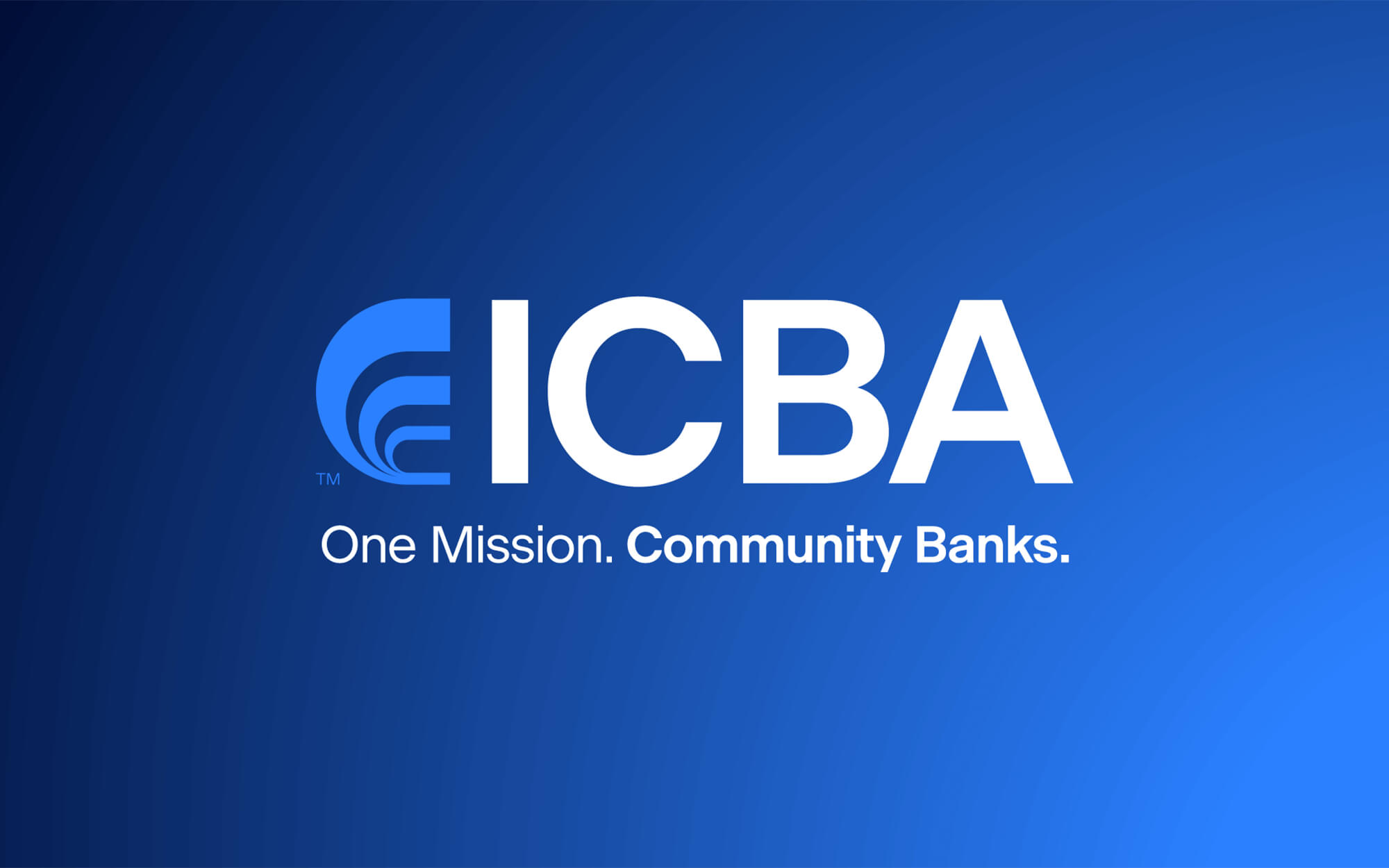|
Mr. Robert E. Feldman |
Download this letter
Dear Mr. Feldman:
The Independent Community Bankers of America (“ICBA”) appreciates this opportunity to provide comment to the FDIC on a proposed rule (the “Proposal”) that would mitigate the deposit insurance assessment effects of participating in the Paycheck Protection Program (PPP) established by the Small Business Administration (SBA), the Paycheck Protection Program Lending Facility (PPPLF) and the Money Market Mutual Fund Liquidity Facility (MMLF) established by the Board of Governors of the Federal Reserve System.
The proposed changes would remove the effect of participation in the PPP and PPPLF on various risk measures used to calculate an insured depository institution’s (IDI’s) assessment rate, remove the effect of participation in the PPPLF and MMLF programs on certain adjustments to an IDI’s assessment rate, provide an offset to an insured depository institution’s assessment for the increase to its assessment base attributable to participation in the MMLF and PPPLF, and remove the effect of participation in the PPPLF and MMLF programs when classifying insured depository institutions as small, large, or highly complex for assessment purposes.
Since ICBA expects that few community banks will participate in the MMLF, we have restricted our comments to how the proposal will impact the PPP and the PPPLF.
Background
Under FDIC regulations, the FDIC charges all IDIs assessments equal to their assessment base multiplied by their risk-based assessment rate. An IDI’s assessment base and assessment rate are determined each quarter based on supervisory ratings and information collected on the Consolidated Reports of Condition and Income (Call Report).
Generally, an IDI’s assessment base equals its average consolidated total assets minus its average tangible equity. An IDI’s assessment rate is calculated using different methods based on whether the IDI is a small, large, or highly complex institution.
For assessment purposes, a small bank is generally defined as an institution with less than $10 billion in total assets, a large bank is generally defined as an institution with $10 billion or more in total assets, and a highly complex bank is generally defined as an institution that has $50 billion or more in total assets and is controlled by a parent holding company that has $500 billion or more in total assets, or is a processing bank or trust company.
Assessment rates for established small banks are calculated based on eight risk measures that are deemed “statistically significant” by the FDIC in predicting the probability of an institution’s failure over a three-year period.
Large banks are assessed using a scorecard approach that combines CAMELS ratings and certain forward-looking financial measures to assess the risk that a large bank poses to the deposit insurance fund (DIF). All institutions are subject to adjustments to their assessment rates for certain liabilities that can increase or reduce loss to the DIF in the event the bank fails.
Without a change to the assessment rules, an IDI that participates in the PPP or the PPPLF could be subject to increased deposit insurance assessments. For example, an institution that holds PPP loans, including loans pledged to the PPPLF, would increase its total loan portfolio which would very likely increase its assessment rate.
An IDI that receives funding through the PPPLF would increase the total assets on its balance sheet (equal to the amount of PPP loans pledged to the Federal Reserve Banks), and increase its liabilities by the same amount, which would increase the IDI’s assessment base and most likely would increase its assessment rate.
The FDIC is proposing to partially mitigate the deposit insurance assessment effects of holding PPP loans and pledging loans to the PPPLF. Under the Proposal, an IDI generally would not be subject to a higher deposit insurance assessment rate solely due to its participation in the PPP or the PPPLF.
In addition, the FDIC would provide an offset against an IDI’s assessment amount for the increase to its assessment base attributable to participation in the PPPLF. To mitigate the assessment effect of PPP loans, including loans pledged to the PPPLF, the FDIC is proposing to exclude PPP loans held by an IDI from its loan portfolio for purposes of calculating the IDI’s loan mix index or LMI.
The FDIC is proposing using a waterfall approach for excluding PPP loans from the LMI. Since most banks are categorizing their PPP loans as C&I loans, the FDIC would first exclude those loans from the LMI. If there are additional PPP loans, they would then exclude them from the All Other Loans category and then from the Agricultural Loans category.
This would avoid requiring banks to separately report all their PPP loans on their Call Reports. The FDIC is also proposing to modify various risk measures to exclude loans pledged to the PPPLF from total assets and to exclude borrowings from the Federal Reserve Banks under the PPPLF from total liabilities when calculating an IDI’s deposit insurance assessment rate.
Using an offsetting approach to reduce the total assessment amount, the FDIC would calculate the total of the quarterly average amount of assets pledged to the PPPLF, multiply that amount by an IDI’s total base assessment rate (after excluding the effect of participation in the PPPLF, as proposed), and subtract the resulting amount from an IDI’s total assessment amount.
Interested in discussing this and other topics? Network with and learn from your peers with the app designed for community bankers. Join the conversation with ICBA Community.
ICBA’s Comments
ICBA commends the FDIC for its proposal to reduce the deposit insurance assessment impact on an IDI that is originating or purchasing PPP loans or participating in the PPPLF. The dramatic steps taken to fight COVID-19 have had a profound effect on the economy and millions of small businesses have been severely impacted. To provide liquidity to small businesses and to help stabilize the broader economy during this period, community banks should be encouraged to originate and hold PPP loans without any adverse regulatory impact and, if necessary, participate in the PPPLF.
ICBA commended the banking agencies when they proposed neutralizing the regulatory capital effect of participating in the PPPLF by assigning a zero percent risk weight to PPP loans originated by the banking organization for purposes of risk-based capital requirements. The agencies have also allowed IDIs to exclude exposures pledged as collateral to the PPPL Facility from a banking organization’s total leverage exposure, average total consolidated assets, and standardized total risk-weighted assets. The treatment also extends to the community bank leverage ratio.
However, ICBA recommends that the FDIC go further with the Proposal and exclude all PPP loans from any impact on an IDI’s deposit insurance assessments. Not only should PPP loans be excluded from the loan mix index (i.e. LMI), they should also be excluded from the calculation of any other index used to determine an assessment rate that could adversely impact an IDI’s deposit insurance assessment rate, including an IDI’s one-year asset growth measure and the nonperforming-loans-to-gross-assets ratio.
Furthermore, whether they are categorized as C&I Loans, Agriculture Loans, or All Other Loans, PPP loans should be excluded from any risk measure used to determine an IDI’s deposit insurance assessment rate if their inclusion would adversely affect the IDI’s assessment rate.
Under the Proposal, for established small banks, the outstanding balance of loans pledged to the PPPLF would be excluded from the total assets in the calculation of six risk measures used for determining assessment rates. But for small banks with PPP loans that were not pledged as collateral for the PPPLF, the PPP loans would only be excluded for purposes of determining the LMI.
We believe this unfairly penalizes the community bank that originates and holds PPP loans but that does not use the PPPLF. As we have stated, PPP loans should be excluded from any risk measure if their inclusion would adversely impact a community bank’s deposit insurance assessment rate.
Furthermore, ICBA recommends that PPP loans should be excluded from an IDI’s assessment base for purposes of determining deposit insurance assessments. The exclusion should not just apply to PPP loans that are pledged for the PPPLF. Otherwise, community banks that did not participate in the PPPLF will be treated differently from those that did creating an unnecessary inequity in deposit insurance assessments. ICBA expects that, by the end of the third quarter as a result of the SBA forgiveness program, most of the PPP loans will disappear off the balance sheets of community banks. Therefore, these recommendations for changing the FDIC proposal, if implemented, should not have much impact on Deposit Insurance Fund.
Conclusion
While ICBA commends the FDIC for its proposal to partially mitigate thedeposit insurance assessment impact of originating and purchasing PPP loans and participating in the PPPLF, we recommend the FDIC go further with its proposal and eliminate completely the impact particularly for banks that do not participate in the PPPLF.
All PPP loans should be excluded not only from the calculation of the LMI, but from any measure used to calculate an IDI’s assessment rate if their inclusion would have an adverse impact on an IDI’s assessment rate. Furthermore, all PPP loans should be excluded from an IDI’s assessment base. To do otherwise will unfairly penalize those banks that do not participate in the PPPLF.
ICBA appreciates the opportunity to comment on the FDIC’s proposal to mitigate the deposit insurance assessment effect of participation in the PPP and the PPPLF. If you have
any questions or would like additional information, please do not hesitate to contact me at Chris.Cole@icba.org.
Sincerely,
Christopher Cole
Executive Vice President and Senior Regulatory Counsel






